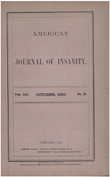Trends in pharmacotherapy of Schizoaffective and bipolar affective disorders: a 5-year naturalistic study
Abstract
OBJECTIVE: The authors' goal was to determine if the actual treatment of schizoaffective and bipolar affective disorders had changed in light of recent clinical drug trials that have suggested that valproate and carbamazepine may be equivalent in efficacy to lithium. METHOD: Medication utilization rates for each 6-month period from July 1, 1989, to June 30, 1994, were compiled from the clinical database of the Palo Alto Veterans Affairs Medical Center. Results: The use of valproate and valproate plus lithium was negligible in 1989. by 1994, these medication regimens accounted for 25% of the standard antimanic treatments used for bipolar affective disorder and 38% of the treatments used for schizoaffective disorder. Regimens of carbamazepine and carbamazepine plus lithium dropped from 24% of antimanic treatments in 1989 to 18% in 1994. From 1989 to 1994, there was a decline in the rate of lithium monotherapy for treatment of bipolar affective disorder (from 84% to 43%) and schizoaffective disorder (from 100% to 53%). CONCLUSIONS: In the past 5 years, valproate monotherapy has increased as a percentage of total antimanic pharmacotherapies, while lithium monotherapy has declined.
Access content
To read the fulltext, please use one of the options below to sign in or purchase access.- Personal login
- Institutional Login
- Sign in via OpenAthens
- Register for access
-
Please login/register if you wish to pair your device and check access availability.
Not a subscriber?
PsychiatryOnline subscription options offer access to the DSM-5 library, books, journals, CME, and patient resources. This all-in-one virtual library provides psychiatrists and mental health professionals with key resources for diagnosis, treatment, research, and professional development.
Need more help? PsychiatryOnline Customer Service may be reached by emailing [email protected] or by calling 800-368-5777 (in the U.S.) or 703-907-7322 (outside the U.S.).



